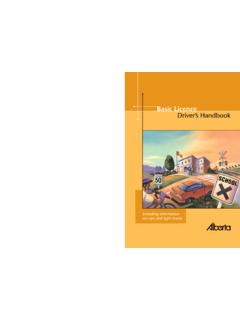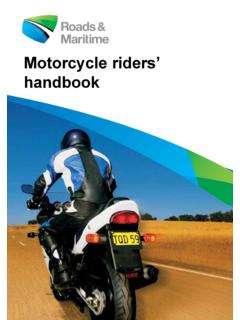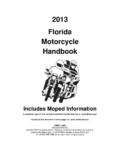Transcription of labour-based road works - International Labour …
1 Contractor's handbook Labour - based road works Republic of Zambia Ministry of works and Supply Roads Department, Roads Training School Contractor's handbook for Labour - based road works Republic of Zambia Ministry of works and Supply Roads Department Roads Department Training School International Labour Organisation ASIST. Advisory Support Information Services and Training This manual has been produced with financial support from the Norwegian Agency for Development Cooperation (NORAD) in cooperation with Roads Department Training School (RDTS). Consultant: (Intech Beusch & Co.). Technical assistance and editing: Tomas Stenstr m (ILO/ASIST) Harare Cover illustration: Dan Amayo 2004. ACKNOWLEDGEMENT. This handbook has been prepared by Roads Department Training School (RDTS), Ministry of works and Supply in collaboration with Intech Beusch & Co., Consulting Engineers and the International Labour Organisation (ILO/ASIST).
2 The idea behind this handbook was hatched by Messrs. Carl-Eric Hedstr m and Sturla Elvsveen of RDTS. The concept is based the Swedish handbook BYGG. The management team of Roads Department Training School would like to express their gratitude to the consultant Mr. Andreas Beusch and Mr. Tomas Stenstr m (ILO/ASIST) whose contributions to the development of this handbook have been invaluable. THIS handbook . This handbook is aimed primarily at small-scale contractors and covers all relevant and important aspects of Labour - based road works in Zambia. However, certain modules might also be useful for any contractor working in other fields of construction than roads. The handbook provides practical tables, guidelines and recommendations in a concentrated format for use on site. It is written in an easy understandable language so that it may be also useful to site supervisors. The handbook , however, is not a training manual and has been prepared with the assumption that users have previously attended adequate training in road works .
3 The handbook is the property of the Roads Department Training School, Ministry of works and Supply, Box 34596, Lusaka, Zambia. All correspondence concerning the contents of this handbook should be directed to this address. Roads Training School of the Roads Department, Ministry of works and Supply, Box 34596, Lusaka, Zambia. 2004. TABLE OF CONTENTS. Module A: A. CONSTRUCTION MEASUREMENTS AND. CALCULATIONS A-1. Introduction A-1. Lengths A-1. Areas A-1. Volumes A-2. Weight and Capacity A-3. Density A-4. Slopes (as ratio and percentage) A-4. Pressure A-5. Practical Calculation Example for Volumes A-6. Unit Conversions A-8. Module B: B. SOILS B-1. Introduction B-1. Soil Terminology and Definitions B-1. Soil Characteristics B-2. Summary Soil Classification B-2. Identification of Soils B-2. Characteristics of Soils for road work B-6. Some Common Soil Types in Zambia B-6. Module C: C.
4 SITE CAMP AND TOOLS C-1. Introduction C-1. Site Camp C-1. Hand Tools C-2. Module D: D. SETTING OUT D-1. Introduction D-1. Measuring Aids and Instruments D-1. Setting out a Straight line D-4. Setting out Angles D-4. Setting out Horizontal Curves D-5. Setting our Gradients and Levels D-7. Module E: E. Labour - based road CONSTRUCTION E-1. Introduction E-1. Common Terms E-1. Standard Cross-Sections for Rural Roads E-5. work Management E-12. Site Inspection E-12. Site work Planning E-13. Site Camp Establishment E-16. Site Organisation and Staffing E-18. Recruitment of Labour E-18. Site Planning, Reporting and Monitoring E-18. CONTRACTOR'S handbook Ed. ( ) -I. Earth road works (Activity Sheets) E-19. Quality Control for Earth road works E-38. Culverts E-38. Definitions E-38.. Manufacturing Culverts E-39. Setting Out E-40. Bedding and Haunching E-44. Small Structure works E-46. Introduction E-46.
5 Common Structures for Rural Roads E-46. Important Considerations for the Construction of Structures E-48. Gabion works E-49. Gravelling E-51. Planning and Organising works E-51. Equipment and Tools E-52. Gravelling Activities (Activity Sheets) E-53. Quality Control for Gravelling E-61. Module F: F. COMPACTION F-1. Introduction F-1. Factors Influencing Compaction F-1. Compaction Plant F-2. Field Density Tests F-4. Module G: G. CONCRETE TECHNOLOGY G-1. Introduction G-1. Materials for Concrete G-1. Aggregates G-1. Cement G-1. Water G-2. Types of Concrete G-2. Mixing of Concrete G-3. Batching G-3. Mixing G-3. Water Cement Ratio G-4. Transporting Concrete G-5. Placing Concrete G-5. Construction Joints G-6. Definition and Purpose G-6. Construction Joint Between Foundation and Wall G-6. Joints for Retaining Walls G-7. Joints for Floor Slabs G-8. Curing Concrete G-8. Removal of Formwork G-8.
6 Quality Control for Concrete works G-9. Module H: H. STONE MASONRY work H-1. Introduction H-1. Materials for Stone Masonry (cement bound) H-1. Mortar H-1. CONTRACTOR'S handbook Ed. ( ) - II. Quantities H-2. Stone Masonry work H-3. Foundations H-3. Construction of Walls H-3. Dry Stone Masonry (without mortar) H-4. Brick and Block Masonry work H-5. Quality Control for Mortar H-7. Module I: I. CULVERT PRODUCTION I-1. Introduction I-1. Manufacturing Facilities and Resources I-1. Casting I-1. Stripping and Curing I-2. Loading, Transport and Off-Loading I-2. Module J: J. TRAFFIC CONTROL AND SAFETY J-1. General J-1. Standard Signs J-1. Traffic Control J-2. Module K: K. road MAINTENANCE K-1. Introduction K-1. Common Maintenance Terms K-1. Maintenance Operations and Activities K-5. Management for Routine Maintenance work K-7. Management Cycle K-7. Organising Routine Maintenance works K-7.
7 Routine Maintenance Activities for Drainage of Paved and Unpaved Roads, Carriageway of Unpaved Roads K-10. Routine Maintenance For Carriageway of Paved Roads K-24. Module L: L. MAINTENANCE OF PLANT AND VEHICLES L-1. Introduction L-1. Workshop Set-up L-1. Control System L-3. Maintenance of Plant L-5. Module M: M. PRODUCTIVITY GUIDELINES M-1. General M-1. Productivity Rates for Earth road works M-1. CONTRACTOR'S handbook Ed. ( ) - III. Productivity Rates for Gravelling works M-3. Productivity Rates for Hauling Equipment M-5. Productivity Rates for Routine Maintenance works M-6. Module N: N. work PROGRAMMING AND REPORTING N-1. Introduction N-1. Required Plans and Reports N-1. Planning Process N-2. Useful Planning Checklists N-3. Module 0: 0. CONTRACT PROCEDURES O-1. General O-1. Contracting Parties O-2. Contract Documents O-2. Tender Procedures O-3. Contract Implementation O-5.
8 Mobilisation O-5. Contract Supervision O-8. Contract Administration O-10. Dispute Procedure O-12. Demobilisation O-13. Maintenance Period O-15. Post Construction Evaluation O-17. Records O-17. Productivity and Cost Control O-17. Module P: P. Labour RECRUITMENT AND ISSUES, SAFETY AND. HEALTH ON SITE P-1. Labour LAWS AND REGULATIONS P-1. Introduction P-1. General Labour Regulations P-1. Labour RECRUITMENT AND REMUNERATION P-3. SAFETY AND HELATH ON SITE P-6. HIV AND AIDS P-6. REFERENCE MATERIAL. INDEX. CONTRACTOR'S handbook Ed. ( ) - IV. MODULE A: CONSTRUCTION MEASUREMENTS AND CALCULATIONS. Introduction A-1. Lengths A-1. Areas A-1. Volumes A-2. Weight and Capacity A-3. Density A-4. Slopes (as ratio and percentage) A-4. Pressure A-5. Practical Calculation Example for Volumes A-6. Unit Conversions A-8. Construction Measurements and Calculations Module A. INTRODUCTION: In road works technical personnel are often confronted with situations where a basic knowledge of mathematics becomes necessary.
9 These include: setting out of vertical and horizontal alignments, detailed setting out of work tasks, calculation of earth volumes, calculation of areas for clearing, calculation of equipment performance rates, estimation of performance rates for Labour , calculation of masonry and concrete work , and many more. World wide the metric system is the universal system of measurements (System International = SI) with standard units for length, weight, time, temperature, etc. A. conversion table with the most common units is provided at the end of this module. Do not mix the measurement systems and units. Before you make any calculations you have to make sure that you use one system and one unit only. LENGTHS. Definition = the standard unit for length is the metre (m). For shorter lengths centimetre (1m = 100cm) is used which is again subdivided into millimetres (1cm = 10mm). for longer distances however, kilometre (1000m = 1km) is used.
10 Conversion: mm cm m km 1mm 1 1cm 10 1 1m 1,000 100 1 1km 1,000,000 10,000 1,000 1. Length; for construction work the most common and practical units are metres and centimetres. AREAS. Definition = 1m2 is the area of a square having sides whose length is 1m. Consequently every unit of length can be converted into an area if it is multiplied by itself. Therefore: mm x mm = mm2 cm x cm = cm2 m x m = m2 km x km = km2. Other special units are: 10m x 10m = 100m2 = 1are 100m x 100m = 10,000m2 = 1hectare It is always advisable when working out areas to make sure that all the units are the same. Relationship between the various units or areas: mm2 cm2 m2 hectare km2. 1mm2 1 1cm2 100 1 1m2 1,000,000 10,000 1 hectare 10,000 1 1km2 1,000,000 100 1. Note: to convert the area to one unit higher multiply it by 100 and from a higher to a lower unit divide it by 100 as shown above. CONTRACTOR'S handbook Ed.
















